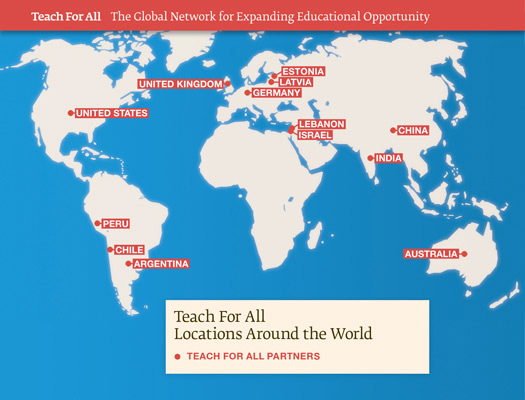
June 19, 2010
Teach For All

Reforming education is a daunting challenge in any country. Just witness the continuing debate in the U.S. among supporters and critics of the controversial No Child Left Behind initiative. Now expand that discussion to a global scale, taking in the entrenched education systems, attitudes and bureaucracies that compete for control in each country, and the hurdles facing educational reform grow exponentially. This was a critical consideration for Wendy Kopp when she decided in 2007 to share the model she developed in Teach For America, which seeks to expand educational opportunities in the U.S., globally. “We have our hands full in the U.S.,” Kopp recalls thinking. “The magnitude of the problem is huge and we have so much to do.”
Yet the gains made by Teach For America suggested that its model and unifying principles might be applicable in other countries. Founded more than 20 years ago, the organization recruits outstanding recent college graduates for two-year teaching stints in low-income and under-achieving schools, preparing them to take on important roles in education and other influential sectors. “The idea is based on a universal truth that it makes sense to channel the energy of future leaders against a society’s most fundamental problems,” says Kopp, who is now chief executive of Teach For All, the global network she subsequently co-founded based on the Teach For America concept. (Teach First, the equivalent UK-based initiative founded by Brett Wigdortz in 2002, was a co-founder in creating Teach For All.) Today, that network stretches to 13 countries, from China and India to Australia and Chile, with six more — including Brazil and Bulgaria — in start-up phase. Despite the diversity of these nations and their different educational systems, Kopp says she is convinced that being part of the network will “accelerate education in each country and be a source of innovation.”
Educational inequality is indeed global, and it occurs without regard to a nation’s economic or social development. In Chile, for example, 95 percent of children in the highest income group complete secondary school while only 30 percent in the lowest income group do so. In Australia, students in the low-income group are 2.5 years behind the average in science, reading and math skills. Half of low-income American students do not graduate from high school. Given Teach For America’s impressive credentials — more than 7,000 corps members are currently reaching more than 450,000 students, and nearly 17,000 alumni are leaders in education and social reform — it’s not surprising that inquiries about joining the network have arrived from more than 80 countries over the past two years, according to Ryan Wise, Teach For All’s managing director for growth strategy.
Participation in the network is based on the local-global practice of having a grassroots social enterprise run each country’s effort while also being part of the broader structure. “Our theory of change,” Wise explains, “is that we are a network of independent organizations with locally staffed and funded groups but which align to a core series of principles that are adapted to the local context. It hinges on local entrepreneurs knowing that context.” Those basic principles include recruiting the most promising future leaders and providing them with training, placing them in areas of educational need, fostering a network among alumni and focusing on short-term student achievement and long-term measurable leadership development.
While the principles remain constant, the origins of the local social enterprises can vary: in the United Arab Emirates it started with a semi-governmental organization that agreed to incubate a Teach For All program, while in Bulgaria the initiative began with a foundation. The organization in China is unique in that it positions both Chinese and North Americans in leadership roles. These are not government-run groups, although government involvement on some level — as in China, where Communist Party officials “embraced” the idea, Wise says — is possible and often necessary to implement a program. But for the most part, Teach For All “believes in the role of the social entrepreneur” as the best way to promote social innovation, says William Drenttel, the organization’s design director. [Note: William Drenttel is also editorial director of the Design Observer Group.]
One important aspect of the network is that it is entirely demand-driven. There are no evangelists for Teach For All who roam the world to seek converts. Instead, motivated individuals in each country — many, educators or management consultants — inquire about starting a local organization and receive guidance and help from the network. “We are not exporting a program,” Drenttel adds. “We are sharing models of success rooted in expertise and core values.”
Each country, of course, presents unique challenges. In Brazil, for example, the organization was confronted with strict government regulations stipulating that teachers have a specific degree and pass a public examination — requirements that Teach For All participants would not necessarily have. But a special program called Schools For Tomorrow, started by Rio’s municipal secretariat for education, offered a solution. Currently public schools in Brazil are legally required to operate only half day, a situation that does not provide adequate instruction time in low-income and underserved communities. As part of the Schools for Tomorrow program, Teach For All participants are allowed to teach in schools for the extra half-day, without the usual credentials. While participants might not be viewed “officially” as teachers, Wise explains, “they will nonetheless be seen as and act as teachers for all stakeholders: parents, students, teachers, and the community in general.”
The decentralized structure of Teach For All is reflected in its design and branding. There is no unified look and logo across the network because “we don’t want to impose a single identity on independent, local organizations,” Drenttel explains. Instead, local partners develop their own identities, although their names are generally variations of the “Teach For…” and “Teach First…” models. The Teach For All graphic identity for the network is light on logos and branding jargon, and has “a simple stripe as an anchor consistent with being a network.” He also sees Teach For All as an excellent example of design thinking, with its emphasis on core values, researching options, aiming for human-centered solutions, crafting iterative approaches, and rapid prototyping to encourage fresh thinking. Teach For All, he says, “is one of the most design-forward organizations, even though the word ‘design’ is not part of their daily vocabulary.”
In background of this initiative are key questions of outcomes and effectiveness. Like any educational reform movement, the Teach For America and Teach First models have come in for criticism. Some argue that it replaces experienced teachers with newly minted beginners and places them in tough, disadvantaged schools where the teaching environment requires unique skills. Questions have also been raised about the actual impact of these teachers.
A slew of reports available on the Teach For America website suggests generally positive outcomes, as do reports about Teach First in the U.K. A study in North Carolina, for example, notes “corps members had a greater impact on student achievement than did traditionally prepared teachers from UNC’s [University of North Carolina’s] teacher preparation program in middle school math, high school math, high school science and English.” In Louisiana, they “outperformed other new teachers with the same level of experience and were as effective as veteran teachers across the state in math, science, reading and language arts.”
So far, it is too early to measure the impact of the individual country organizations across the Teach For All network because many are just beginning to field participants. But in the U.S. and the U.K., there are significant numbers to support the efficacy of the Teach For America model, which continues to attract top graduates. This year Teach For America received a record 46,000 applications — including 12 percent of all seniors at Ivy League schools — and had an acceptance rate of 12 percent. Teach For America representatives say that 63% of the organization’s 17,000 alumni continue to work for educational change and reform in many of the highest-performing schools in low-income communities, as well as in government and other fields involved with education policy. In the U.K., more than 40 percent of 1,000 Teach First alumni are in education leadership roles, the organization says.
While the local organizations in the network are responsible for their own funding and governance, they receive extensive support from Teach For All staff based around the world. In the start-up phase — which can take up to 2 years — they help the local social entrepreneurs understand the model, gauge feasibility and develop a business plan appropriate for that particular country. Once a member of the network, Teach For All provides a person on the ground in each country as well as a country support team of experts available for virtual consultations. Being in the network provides access for participants and alumni to build skills and knowledge and collaborate, and provides technical assistance in the areas of teacher recruitment, selection, training and professional development. They also learn about alumni leadership development and how to cultivate public and private support. Teach For All’s annual $8.6 million budget is funded by global foundations, corporations and individuals — including Nduna Foundation, HSBC Global Education Trust, Michael and Susan Dell Foundation, Visa and New Profit — and supports a staff of 46.
The Teach For All network is still in an early phase of development, but Nick Canning, its chief operating officer, figures there is no natural limit to its size. “We are interested in doing as much as we can and having as much impact as possible,” he says. One future target area is Africa, “where there is the greatest need and the greatest potential,” he says. Kopp believes the organization will be able to accelerate growth and support between 50 and 60 organizations in the network within five years. “The ultimate vision is to create a network that is building and fueling an unstoppable movement to ensure educational opportunities for all in dozens of countries,” she says. “If we can reach that point, we will have created a powerful force for change around the world.”
Observed
View all
Observed
By Ernest Beck

 Ernest Beck is a New York-based freelance writer and editor.
Ernest Beck is a New York-based freelance writer and editor.


